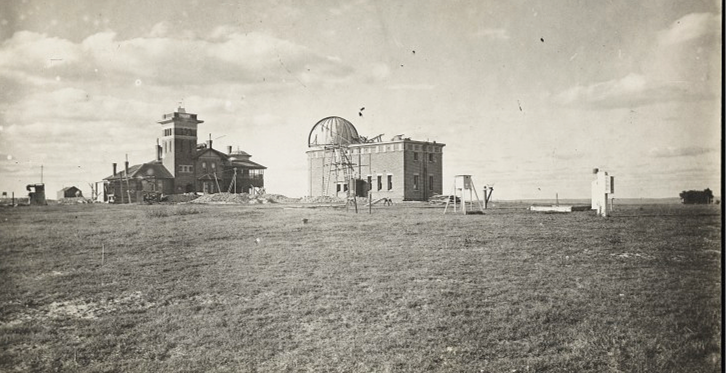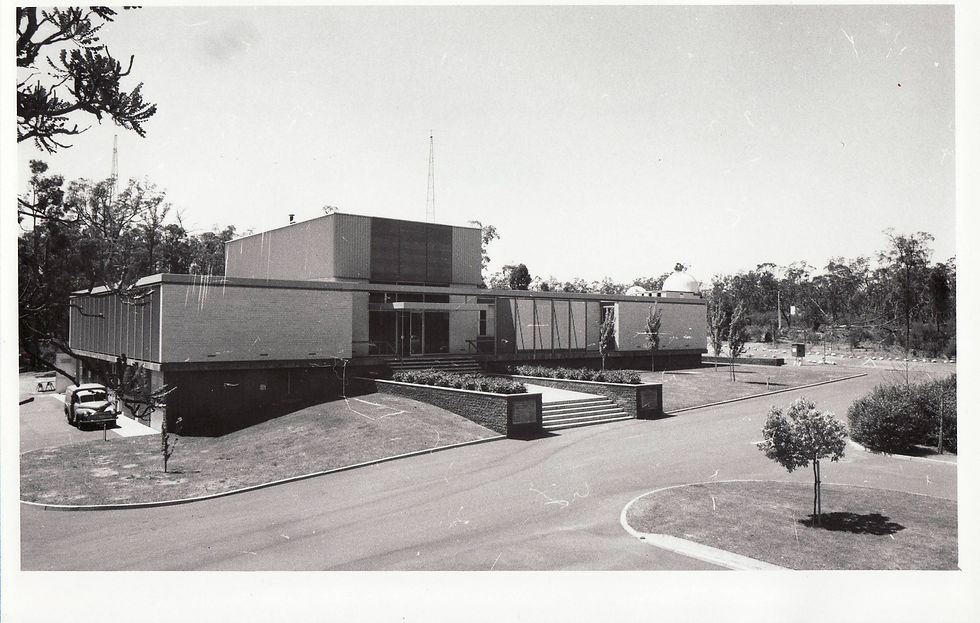Perth Observatory
- Craig Bowers
- Sep 30
- 6 min read

The State-owned Perth Observatory had existed in Western Australia for over one hundred and seventeen years by the time it was closed for research in 2013. It had served a Colony and a State in delivering various scientific services to the people and the government of the day, as well as contributing to the international astronomical and scientific knowledge base. Its early life was born out of the needs and challenges of a new society; an initial British settlement and later colony founded in a new and strange land with few of the comforts of the British homeland. Some of the foundation services, such as surveying and weather observations were essential for the fledgling Colony and had their roots in the State’s Survey Office formed in 1829.
Perth Observatory has been located at two sites in its history, the first at Mt Eliza on the outskirts of Perth City and later in the Perth Hills at Bickley. It has three Minor Planet Center (MPC) site codes 319, 322 and 323 due to the discovery of minor planets at its sites and with its instruments.
Mt Eliza.
Perth Observatory was founded on 29 September 1896 on a site overlooking the early Perth central business district. Its first task after foundation was to improve meteorological forecasting as well as assist in matters of geodesy, navigation, seismology and tides as well as assisting in surveying and defining the States’ boundary, all practical and essential services. In 1899 it received two telescopes, a standard 13-inch Astrograph by Grubb and a 6-inch Troughton & Simms Meridian Transit Circle, additionally two Milne Seismographs were installed.
By 1901 astronomy became an essential part of its business when it was asked to take over the Astrographic Catalogue Zone -31° to -41° Dec., approximately 229,000-star positions. By 1908 meteorology was transferred to a newly formed Commonwealth department, but Perth Observatory still remains a meteorological site to this day. In 1910 it received a 12 ½ inch Calver telescope in preparation for comet Halley. With the First and Second World War and the Great Depression, staff numbers were only maintained at a level to keep the doors open and provide essentail services. However, in the late 1950s staffing levels at the Observatory rose.
As a result of a grand WA Government plan for developing Metropolitan Perth in 1955, the land the Observatory had resided on was earmarked for the location of a Government Precinct that would see five Government towers erected on the site. Perth Observatory was initially to be relocated in the early 1960s, and then it was to be possibly closed due to the early and sudden death of its then Government Astronomer. Fortunately the observatory survived and moved to the hills east of the City to continue its work, but with a program more focussed on astronomy research than in its earlier years.
Between 1901 and 1963 Perth Observatory directors and staff had undertaken many significant activities. They had consolidated meteorological recordings from 1896 to 1908 to produce the first book on the climate of Western Australia and set up accurate time for the State (1899) after defining the Latitude for the State (1899). The Astrographic Catalogue Zone plates assigned to Perth had been completed and they had created the first catalogue of double stars for Declination -32, constructed Meridian catalogues for the entire Perth Astrographic Catalogue zones. The 129th Meridian, defining the eastern border of WA,had been surveyed and the team sent to observe the 1922 total solar eclipse at Wallal had provided critical time and surveying services to the Lick Observatory and other expeditions. Perth Observatory provided the US Navy time services during the war and they commenced seismological recordings and setup tide services for the North West. Perth Observatory was involved in early artificial satellite projects (Project Moonwatch), involved in the determination of Ephemeris Time and provided the all-important day and night tours and newspaper information services for the layman. It had also endured at least 3 attempts of closure.

Bickley.
The second foundation stone for Perth Observatory was laid 30 kilometres east of Perth on 30 September, 1966. This was almost 70 years to the day from the laying of the first foundation stone on Mt Eliza. Unfortunately, the Government saw this as an opportunity to again relocate more services to the Commonwealth, this time Seismology, however the Observatory continued to provide other services.
The new Observatory continued its astrometric work using the original Grubb Astrograph and, as a result of the outcomes of a worldwide traveling fellowship tour by the Observatory’s third Government Astronomer, accepted an offer for a German expedition to setup a new semi-automated Meridian telescope on the site. In addition, the Americans located a 24-inch Boller & Chivens telescope (called 'The Lowell' ) at Bickley during the Apollo missions. This telescope was large for its time. The University of Western Australia also setup a research telescope allowing the Observatory to move into more astrophysical fields of observation.
The new Observatory was rewarded by an increase in staff as the space race was seen as a valuable scientific avenue for Australia and the West Australian government to fund.
The Astrographic telescope commenced a program of second epoch plates with the same centres as those taken between 1901 and the 1940s with a view of investigating proper motions. In addition, investigations on minor planets and comets commenced. In 1970 observing efforts were rewarded with its own minor planet discovery, MP 2993 Wendy. The Hamburg Meridian expedition was successful, and the Perth 70 positional catalogue is still renown today. After the German team left in 1971, the telescope remained on loan and the Perth Observatory staff observed and created two new catalogues, Perth 75 and Perth 83.
The University of Western Australia telescope, a redeveloped CATTS telescope of the late 1800s, was used to not only to teach and train students at all tertiary levels but assisted in programs on the discovery of the rings of Uranus in 1977 as well as being used to observe the apparition of comet Halley in the 1980s. The American ' Lowell' telescope had been initially used as part of the NASA funded International Planetary Patrol Program to obtain uninterrupted imaging to investigate the day-to-day and hour-to-hour changes in the large-scale atmospheric and surface features of the planets. After this, the telescope was fitted with a photometer, and this enhanced Perth Observatory's observation of comets and minor planets. Later the telescope was automated and worked on supernova searching as well as micro-lensing events.
On 21 October, 1976, Perth Observatory (Bickley) was State Heritage listed.
By 2013, Perth Observatory staff had completed 2nd epoch observatory of the Perth Astrographic Zones, recovered five lost comets, provided 10% of all ground-based observations of Comet Halley, discovered 27 new minor planets and been involved in many international observing programs. After 100 years of observing the astrographic telescope was replaced in 1999 by an automated telescope. The Hamburg Meridian Transit circle produced three prestigious Southern Hemisphere catalogues before being shutdown in 1987 and returned to Germany. The 'Lowell' telescope not only remained the only other one outside America in the International Planetary Parol Program in the late 1970s, but with the attachment of a photometer would see it changing theories on comets and minor planets until the late 1990s. It was responsible for the co-discovery of the rings of Uranus, ‘jets’ in Comet Halley and a Supernovae discovery.
In 2017 the Observatory completed a National Library of Australia 'Significance Assessment', and in 2019 a 'Needs Assessment'. It has digitised over 20,000 photographic glass plates and hundreds of State records of the work undertaken between 1896 and 2013.
Closure
Perth Observatory was to endure several more attempts at closure after its relocation to Bickley and in 2013 finally succumbed to all staff leaving due to Government funding being reallocated to other projects. It remains open today for tours by a volunteer group.
Conclusion
The Perth Observatory’s history is one of resilience, adaptation and inspiration. Founded initially to service the practical needs of a Colony and then a State, it grew into a centre of excellence on the world stage contributing to humanity’s exploration of space while retaining its deep engagement with the public.
The Observatory site and collection is a reminder of Western Australia's global connections in astronomy, and the search for knowledge by its directors and staff, despite funding and staffing challenges. There is continuing research into this history and ongoing digitisation projects that today are delivered by a dedicated group of astronomers and staff, often in their own time.
About the author:
Dr Craig Bowers is an astronomer and worked at Perth Observatory, Bickley. His doctoral thesis is titled: 'The scientific history of the Perth Observatory from 1960 to 1993'. Craig works as the honorary historian at Perth Observatory, where he continues the tradition of writing a guide to the night sky for a WA newspaper and is on the Perth Observatory heritage team. Craig is a member of the HAAC Committee.
References:
Haynes, R., Haynes, R. D., Malin, D., and McGee, R.,(2010) Explorers of the Southern Sky, Cambridge University Press,pp 90-94. Link: https://www.cambridge.org/au/universitypress/subjects/physics/history-philosophy-and-foundations-physics/explorers-southern-sky-history-australian-astronomy
Utting, M., (1993) Astronomy in Western Australia. Link: https://researchportal.murdoch.edu.au/esploro/outputs/991005541631407891
Utting, M., (1999) The Perth Observatory, 1940-1962. Link: https://researchportal.murdoch.edu.au/esploro/outputs/991005541079607891
Bowers, C., (2016) The scientific history of the Perth Observatory from 1960 to 1993
Perth Observatory - inHerit - State Heritage Office




Comments